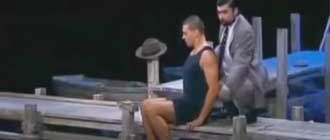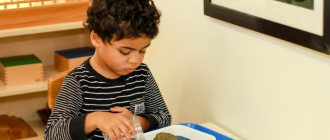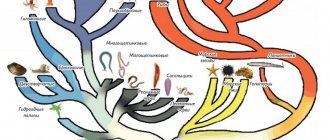Summary of a lesson on familiarization with the outside world in the middle group. Topic: "Hello summer."
Urban district city of Vyksa
MUNICIPAL BUDGETARY PRESCHOOL EDUCATIONAL INSTITUTION
combined kindergarten No. 7 “Goldfish”
607060, Vyksa, st. Kornilova building 97, 8(83177) 3 – 55 – 11, Email: [email protected]
Summary of a lesson on familiarization with the outside world in the middle group.
Topic: "Hello summer."
Completed by: teacher
Highest qualification category
Krasotkina M.A.
Target:
expanding children's understanding of summer as a season.
Tasks :
clarify knowledge about the forest (what benefits it brings, what grows);
develop children's imagination and auditory analyzer;
cultivate a caring attitude towards plants, insects, the forest and its inhabitants.
Preliminary work:
reading fiction; viewing pictures of nature and the animal world; memorizing poems, riddles; observation in nature; learning children's games.
Materials and equipment;
picture cards depicting forests, flowers, insects; illustrations of summer entertainment, pictures of natural phenomena, pictures of a meadow and a country house, audio recording “Sounds of Nature.”
Progress of the lesson
.
—
Guys, listen to the poem and think about what time of year it refers to.?
- Summer is coming soon! Summer is coming soon!
Lots of sunshine!
It's fun to play in the summer -
Jump, run and gallop!
O. Zykova
– Today we will go traveling into the summer! But before we go on a journey, I suggest you solve a riddle.
The house is open on all sides,
It is covered with a carved roof.
Come to the green house -
You will see miracles in it.
Children's answers: forest
Well, now let’s take our seats (the teacher suggests stopping at the first station.
— The first station is "Les".
— People say: “To live in the forest, you won’t go hungry.”
- Why do you think they say that? What grows in the forest? (mushrooms and berries)
— What wild berries do you know? (strawberries, blueberries, blackberries)
— Shall we play the game “Bear in the Forest”?
- It's good in the forest! Let's collect mushrooms and berries as a souvenir of our trip (competition: two teams - one collects mushrooms, the other berries (or flowers).
— The next station is “Lug”.
-Who do you think we will meet in the meadow?
- How does a bee buzz? Let's all buzz together...
- I will ask riddles, and you try to guess, this is what we will call many insects that live in the meadow (a picture is shown for each answer)
Cheren, but not a raven.
Horned, but not a bull.
Six legs without hooves
It flies and buzzes,
And he sits down and is silent. ( bug
)
Not a bird, but with wings,
Summary of the final summer lesson for middle group children in kindergarten
Summary of GCD in the middle group on the topic “See you again, fabulous summer!”
Author: Durasova Elena Nikolaevna – teacher of MBDOU kindergarten No. 2 in the village. Novozavidovsky, Konakovsky district, Tver region. Description of the material: I bring to your attention a summary of the GCD for the middle group on the topic “See you again, fabulous summer!” This material will be useful to kindergarten teachers for conducting summer classes with middle school children. Continuous interaction between the teacher and children will help maintain the attention of preschool children and increase the efficiency of assimilation of the information received. Integration of educational areas: “Socio-communicative development”, “Cognitive development”, “Speech development”, “Physical development”.
Goal: Development of cognitive and play skills of preschoolers. Objectives: 1. Form positive associations for all seasons; 2. To consolidate children’s knowledge about the seasons; 2. Continue to strengthen friendly relations in the children's team; 3. Develop social and communicative abilities of preschool children; Demonstration material: Illustrations of dandelions, roses, cornflowers, daisies, two plastic buckets with toy flowers. Methodological techniques: Game situations, examination of illustrations and subsequent discussion, conversation-dialogue, productive activity of children, summing up.
Progress of the lesson:
Educator: - Guys, do you know what time of year it is now?
Children: - Summer! Educator: - Correct, does it begin or end? Children: - It's ending. Educator: - That's right, now are the last days of August, soon the warmest time of the year will come to an end. What did you do this summer?
(Children tell their stories about how they spent the summer.) Educator: - Yes, you are just great. We not only had fun this summer, but also learned a lot about our unimaginably beautiful world. I can only praise you and suggest you have fun. Let's think about some very interesting riddles. Ready? Children: - Yes! Educator: - Okay, then let's start! There is one such flower, You can’t weave it into a wreath, Blow lightly on it, There was a flower - and there is no flower.
(Dandelion)
Its aroma is both tender and sweet.
She will decorate both the park and the garden for us. They consider her the queen of flowers, but there are too many thorns on the branches. (Rose)
Everyone, I think, will know if they visit the field, This little blue flower is known to everyone.
(Cornflower)
Yellow eyes with white eyelashes, for the joy of people, bees and birds.
They decorate the earth with themselves, Sometimes they tell fortunes on their petals Butterflies love them, insects love These flowers are called... (Daisies)
Educator: - Well done! Now let's take a rest. Swell quickly, bud, Bloom the flower, peony.
(Children stand at some distance from each other, legs apart. On the count of 1 - tilt the head to the right shoulder, 2 - tilt the head to the left, 3 - tilt the head back, 4 - forward. Repeat 2 times.)
The children played with the sun, sunbathed together, but the time has come to leave, so now it will rain.
(Children keep their hands down, legs together. On the count of 1-2 - open your eyes wide, 3-4 - close your eyes. Repeat 3 times.)
And while the sun warms us, we will warm our palms.
(Children hold their hands behind their backs, legs slightly apart. At the count of 1-2, stretch your arms forward, turn your palms up and down, 3-4 - etc. Repeat 3 times.) The sun
warms our legs, they will tan at least a little.
(Children sit down on the floor, legs bent at the knees. On the count of 1-2, stretch your legs forward, tilt your head back, 3-4 – repeat. Repeat 2 times.)
The sun gives us its shine and its fiery greetings!
(Children stand up, hands down, legs together. On the count of 1-4, jump on two legs in place, 5-8 walk in place. Repeat 2 times.) Educator: - Well done, so we missed each other.
Now let's play. A delicate flower somehow grew in a clearing, In the morning it raised its head up.
(Children join their palms and raise them up.)
But then one day the wind rose, And our flower immediately began to flutter.
(Children shake their palms, first slowly, then faster.)
The wind shakes the flower stubbornly Right and left, forward and back. Educator: - That's it, well done! And now I suggest you play the game “Collect a bouquet”. (The teacher divides the children into two teams. Approximately in the middle of the hall there are two plastic buckets with toy flowers, the participants must take turns running to their bucket, take the flower and give it to their team, and so on until all the flowers have been collected, the winner the team that completes the task faster.) Educator: - Well done, friendship won! Guys, our lesson is coming to an end, just like summer, but let’s not be upset, because autumn is a wonderful autumn, it will bring us no less joy and fun. Therefore, let's say together: “See you again, fabulous summer! And hello, wonderful autumn! (The teacher gives gifts to the children.)
We recommend watching:
Scenario of summer entertainment for children of the middle group Scenario of a summer sports festival for the middle group Sports summer festival in kindergarten. Middle - junior group Flower Festival in kindergarten
Similar articles:
Scenario of a summer holiday for children of the middle-senior group of kindergarten
Scenario for the holiday “Hello, Summer” in an outdoor kindergarten for all groups
Scenarios for summer holidays and entertainment in kindergarten
Summary of GCD on the topic: “Hello, summer!” for children of the middle group.
Summary of GCD on the topic: “Hello, summer!” for children of the middle group.
Target:
generalization and expansion of children’s knowledge on the topic “Summer”.
Objectives: Educational:
- consolidate knowledge about seasonal changes in nature, in the summer, about insects, their structure, habitats, about wild berries and mushrooms; — consolidate the ability to solve riddles, classify clothes by season, form adjectives from nouns, and independently evaluate your knowledge.
Educational:
— cultivate a caring attitude and love for nature;
- cultivate environmental awareness.
Educational:
— develop communication skills; improve gross motor skills and coordination of movements; - develop emotional responsiveness. Types of children's activities:
cognitive - research, communication, gaming, perception of fiction, musical perception.
Materials and equipment:
a mat - a clearing with flowers and insects, a caterpillar, threads for a cocoon, a butterfly in a cocoon, a spider, counting sticks, a poster with drawings of clothes, summer hats, flowers and butterflies according to the number of children, ICT: presentations “Where, whose house?, “Who’s the odd one out?”, “Walk in the summer forest,” “Check the basket of mushrooms.” GCD structure.
Organizing time. (The teacher has the sun in his hands)
- Guys, look, the sun has come to visit us. We enjoy the sun at all times of the year. What time of year is it now? (summer). - What other seasons do you know? (Children's answers). Formulation of the problem.
— Guys, we have already talked about summer. To feel comfortable in the summer, you need to choose the appropriate clothes.
D/game “Summer clothes”.
Purpose: to show children’s ability to classify clothes by season. - So, summer clothes have been chosen. I invite you to the summer meadow. Come up, put on caps, panama hats, hats... (children put on hats). - Tell me, why did we put on hats? (children's answers). The teacher praises the children for the correct answer and invites them to play a game: “Summer, summer, summer - what color is it? Come on, tell me, come on, show me. Gently green, like a grasshopper in the grass (they jump like grasshoppers), Yellow, yellow, like sand near rivers (show sand and a river wave), Bright, blue, the most beautiful (raise their hands up, spin around themselves), This is what summer .. (Calm music sounds, children approach the prepared clearing and sit around). Children look at flowers, recognize and name them. The teacher praises the children for correct answers, shows soft green grass and asks: “Who can live here without being noticed?” If the guys have difficulty answering, it suggests that these residents are very small, very tiny. Summarizing the children's reasoning, the teacher says that insects are extraordinary animals, they can hide in the grass so that no one will notice them; wondering what insects children know? (Fly, bee, mosquito, ant, dragonfly, wasp, etc.) - I will tell you riddles about insects, and you will guess them and find this insect in the clearing. The black toddler pulls a load that is not tall enough for him. (Ant.) Reads the poem:
An ant cannot be lazy, an ant lives by hard work.
Everything he sees is dragged into his underground home. - Ants, like bees, are great workers. I suggest you guys turn into little ant brothers. Game "Ants Build a House".
Goal: development of motor activity.
Children line up in two columns. Everyone must move the counting stick to the table and build an anthill. That cow does not moo, has no horns, hooves, tail, does not give us milk, lives under the leaves. This one deftly fights harmful aphids... (ladybug.) All four petals of the flower moved, I wanted to pick it, It fluttered and flew away. (Butterfly.) She is bright, beautiful, graceful, light-winged. She herself looks like a flower and loves to drink flower juice. (Butterfly). The name was taken from a blacksmith, The color is from a cucumber, The wings are from a cloudberry, The legs are from a flea. (Grasshopper.) What a girl: She has a thin waist, Huge eyes, She flies and chirps. (Dragonfly.) She is a generous housewife; It flies over the lawn, fusses over a flower and shares honey. (A bee.) The teacher reminds the children what bees eat as they fly from flower to flower and encourages correct answers. Explains that a bee produces honey from nectar; reinforces the already known word “hardworking”, since these insects love to work; clarifies children's knowledge about the bee house; tells the kids that there are many bees living in the hive. Low mobility game “Helpers”.
- Imagine that the clearing has run out of nectar, the teacher invites the children to fantasize, and a scout bee flew out of the hive to scout, buzzed, flew far, far away, found a clearing, but she couldn’t carry so much nectar alone, and the bee called her friends, pick them up the children give their right hand, the teacher offers to play, prepare your index finger, fly to investigate how many bees we have, the bees are buzzing loudly, they have flown far away, their voice is barely audible (the kids buzz loudly, quietly, they run around the hall, imitating the movements with the index finger of their right hand bees).
The bees sat on a flower, collected nectar and flew home. The teacher carefully places the bee back on the flower, accidentally touching the large green leaves, lifts them, showing the insect hidden under it, and asks the children in surprise who it is? (answers). The teacher carefully removes the caterpillar and shows it to the children, reminding them to be careful with tiny insects; asks the guys if they like fairy tales; offers to tell a fairy tale about a caterpillar. “Once upon a time there was a caterpillar (the teacher shows the toy, strokes it), who considered herself very pretty, but those around her did not like her at all, and everyone who met her said: “Ugh, what an ugly, unbeautiful caterpillar.” And she began to hide from everyone under the leaves. One day the caterpillar became completely sad and, out of resentment, cobwebs came out of her mouth, like tears. She began to wrap herself in it, wrapped herself, wrapped herself (the teacher shows the children how the caterpillar wrapped itself and invites them to play with it, repeat the movements) and turned into a cocoon (the teacher takes out a cocoon from under another sheet and shows it to the children). She felt calm and warm in the cocoon. The caterpillar stuck to a leaf and fell asleep, and when she woke up, she felt that she felt very cramped in the cocoon. She tried to roll over, but something was stopping her, and the caterpillar realized that she now had wings. She straightened them, and the cocoon burst, and a butterfly appeared from the cocoon, she was very beautiful, and everyone who called her scary and ugly began to admire: “Oh, what a beautiful butterfly.” And the butterfly fluttered from flower to flower, and only smiled back at them. After waiting a short pause, the teacher asks whether the children liked the fairy tale, what happened to the caterpillar, and invites them to rejoice at this transformation together with the butterfly and fly a little. “Wings flicker in the field, Butterflies fly in the field, They fly, they spin, They stop on a flower.” (Performing movements according to meaning). - These are the insects that live in the summer meadow. Now let’s complete the tasks that the sun has prepared for us. Completing tasks about insects: D/game “Who lives where?”
Goal: to consolidate knowledge about the places where insects live.
(On the screen there is a picture with insect houses). You need to name the “house” and say what kind of insect lives there. And then this insect will fly into its home. (Children name houses and insects, and the corresponding insect appears on the screen). D/game “Who’s the odd one out here?”
Goal: to consolidate knowledge about the distinctive features of insects.
(There are insects on the screen and a spider among them).
- Guys, look carefully at the pictures and determine which picture is the odd one out here and tell me why? (Children find an extra picture with a spider and explain that insects have three body parts: head, chest, abdomen, insects have six legs, and a spider has more).
- What a great fellow you are, you know so much about insects, look at the screen, the sun is smiling at you, it means you completed the tasks correctly. Walk in the summer forest. — Do you want to take a walk through the summer forest? Then, go ahead! A green friend is waiting for us to visit, Birch trees, linden trees, maples are waiting, Herbs, berries, mushrooms of unprecedented beauty. Pines, spruces to the sky, Green friend, this is... (forest). Physical education minute.
And blueberries grow in the forest, (Squats) Strawberries, blueberries.
To pick berries, you have to squat lower. I took a walk in the forest, (Walking in place) I carried a basket of berries. (Slide “Forest”)
- What grows in the forest in the summer?
(Berries, mushrooms). What berries do you know? Show and name berries you know. (Slide with wild berries: strawberries, raspberries, blueberries, cranberries, currants, gooseberries).
Word game “Which one?” Which?" Goal: strengthening the ability to form adjectives from nouns.
Strawberry juice (what?) – strawberry. Blueberry jam (what kind?) – blueberry. Raspberry compote (which one?) – raspberry. Currant jam (what kind?) – currant jam. - Great, you also know a lot about berries! The sun is smiling at you again. (Slide “The sun is smiling”). The berries have been picked, but what else can you pick in the forest in the summer? (Mushrooms). D/game “Check the mushroom picker’s basket.”
Goal: to strengthen the ability to distinguish poisonous mushrooms by appearance: fly agaric and toadstool.
(Slide “Hedgehog with a basket of mushrooms”)
- Guys, the hedgehog picked mushrooms and doesn’t know if they are all edible. Let's help him sort out the mushrooms. (Slide with pictures of edible and inedible mushrooms).
Children find inedible mushrooms (fly agaric and toadstool) and name them. Conversation “What can happen if you eat a poisonous mushroom?” (Children's answers). Well done guys, you also know a lot about mushrooms. Summer Appears
: How did you end up here? And why did they come here? (Children's answers.)
- What good kids! I don’t feel sorry for anything for such good kids! I brought you gifts - no one else has those. (Summer gives children a fruit basket.)
Our journey is over.
Reflection.
- What did we talk about today? (Children's answers). - To make the summer bright, you and I will plant butterflies in this flower meadow. (Prepare a panel with flowers according to the number of children in advance). “Everyone in turn will take a butterfly, and before planting it on a flower, they will say what they liked best.”




